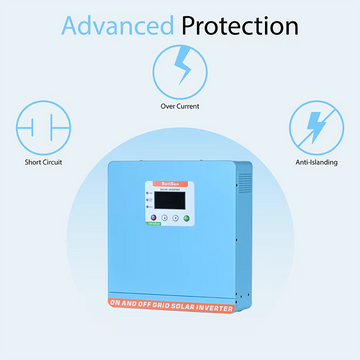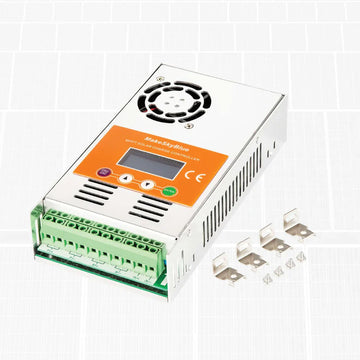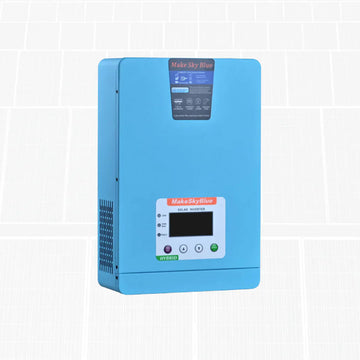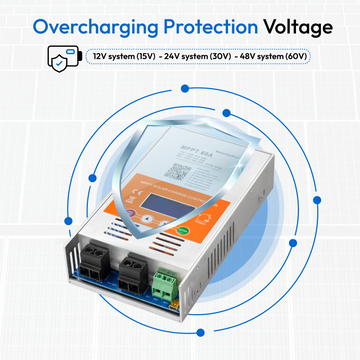The solar charge controller market is projected to hit 2.85 billion dollars in the world in 2024 and is projected to grow by 15.3 percent per year. A 20 amp solar charge controller is used to regulate voltage and current flowing between the solar panels and battery banks to avoid damaging the battery and system breakdown. This gadget guarantees your solar investment to run smoothly over decades and the batteries will not be overcharged and cause electrical risks.
The choice of a good 20 amp solar charge controller has a direct influence on the life of the system and energy efficiency. Power harvesting from sunlight is very sensitive to the technology choice between PWM and MPPT controllers.
What Does a 20 Amp Solar Charge Controller Do?
A 20 amp solar charge controller regulates maximum current flow from solar panels to batteries at 20 amperes. The device continuously monitors solar panel output and battery voltage, automatically adjusting charging behavior to maintain safe conditions.
Key functions include preventing battery overcharge, stopping reverse current during nighttime, protecting against voltage spikes, and enabling temperature-based charging adjustments. Modern 20 amp solar charge controller models incorporate multiple protection layers including short-circuit defense and thermal management systems.
PWM vs MPPT Technology in 20 Amp Controllers
PWM controllers use rapid switching to reduce voltage to battery level. According to 2024 data, PWM controllers account for 45.7% of global shipments despite lower efficiency, because they cost 30-40% less than MPPT models.
MPPT technology continuously adjusts input voltage and current to extract maximum power as light conditions change. MPPT held 67.9% market share in 2024. PWM controllers achieve 70-80% efficiency while MPPT reaches 97-99.5%, harvesting 15-30% more energy from identical solar panels.
Why Your Solar System Needs a 20 Amp Solar Charge Controller?
The 20 amp solar charge controller prevents battery overcharge damage from excessive voltage. Lead-acid batteries risk thermal runaway exceeding 14.4V on 12V systems. Modern models include blocking diodes preventing reverse current discharge through panel wiring during darkness. Temperature compensation automatically adjusts charging parameters based on battery temperature. Consistent voltage output maintains performance and extends component lifespan.
Key Specifications for 20 Amp Solar Charge Controller Performance
|
Specification |
PWM Controller Standard |
MPPT Controller Standard |
Notes |
|
Charging Efficiency |
70-80% |
95-99.5% |
MPPT recovers 15-30% more energy |
|
Voltage Input Range |
Limited |
100-150V Wide Range |
MPPT handles higher panel voltages |
|
Temperature Compensation |
Optional Sensor |
Standard Feature |
Automatic voltage adjustment ±3mV/°C |
|
System Voltage Detection |
Manual Setting |
Auto-Detection |
MPPT auto-detects 12V/24V systems |
|
Battery Type Support |
2-3 Types |
4+ Types |
Lithium, AGM, Gel, Flooded compatibility |
|
Maximum Power Input |
240W (12V) |
260-520W |
12V systems vs 24V systems |
|
Peak Conversion Efficiency |
75-85% |
97-98% |
Heat dissipation via aluminum heatsinks |
|
Load Control Functions |
None |
Available |
Light control, time control modes |
|
Reverse Polarity Protection |
Basic |
Multi-layer |
Over-voltage, over-current included |
|
Working Temperature Range |
-20°C to +50°C |
-25°C to +50°C |
Aluminum design improves thermal stability |
Understanding 20 Amp Solar Charge Controller Safety Features
Protection circuits are provided to prevent damage caused by reverse polarity, short circuiting, overload above 20A and over temperature. Die-cast aluminum enclosures are applied in quality units to facilitate easy dissipation of heat. LCD displays real-time battery voltage, amperometric charging current, daily energy stored and system fault codes. Advanced models include Bluetooth connectivity for smartphone monitoring.
Performance Comparison of Leading 20 Amp Solar Charge Controller Models
|
Model Type |
Tracking Efficiency |
Conversion Efficiency |
Temperature Compensation |
Multi-Battery Support |
Load Control |
Price Range |
|
RICH SOLAR MPPT 20A |
99% |
98% |
Built-in Sensor |
Lithium Capable |
Yes |
$180-220 |
|
PowMr 20A MPPT Keeper |
99.50% |
97% |
Battery Temperature |
Sealed/Gel/Flooded/Li |
Advanced Modes |
$200-250 |
|
HQST 20A MPPT |
99% |
98% |
-3mV/°C/2V |
Flooded/AGM/Gel/Lithium |
Yes |
$160-200 |
|
Newpowa 20A MPPT |
98% |
98% |
Standard |
Gel/AGM/Liquid/Lithium |
Limited |
$150-190 |
|
Majestic 20A MPPT |
99.90% |
98% |
Advanced |
Multi-type |
Full Control |
$210-280 |
|
Standard PWM 20A |
75% |
78% |
Optional |
2-3 Types |
None |
$80-120 |
Installation Best Practices for 20 Amp Solar Charge Controller
Install the 20 amp solar charge controller near the battery bank to reduce the voltage drop. Select vertical surfaces that are not exposed to sunlight and moisture. Safe current handling requires 4-6 AWG copper wiring. Connect solar panels, then battery and then loads to avoid spikes of voltages. Conduct quarterly checks of terminal connections and monthly cleaning to get dust out of the way of heat
MakeSkyBlue Solar Solutions Services
MakeSkyBlue offers solar panels, battery systems, inverters, and complete off-grid packages. Design consultation and installation support ensure your 20 amp solar charge controller integrates optimally within complete systems for RVs, boats, remote properties, and backup power applications.
Conclusion
The 20 amp solar charge controller safeguards your solar investment and also maximizes the energy harvest. The market data indicates that there is a high awareness with the solar charge controller industry increasing by 15.3 percent every year up to 2030. The choice of Quality 20 amp solar charge controller will guarantee the battery life, the reliability of the system, and the enhanced energy independence.
Frequently Asked Questions
What is the actual difference between PWM and MPPT 20 amp solar charge controllers?
PWM controllers achieve 70-80% efficiency through simple switching, costing 30-40% less. MPPT reaches 97-99.5% efficiency by tracking optimal power points, recovering 15-30% additional energy within 3-5 years.
Can a 20 amp solar charge controller handle both 12V and 24V systems automatically?
Modern MPPT controllers auto-detect 12V or 24V system voltage when connected to standard batteries. Manual configuration applies only to lithium batteries.
How long typically does a quality 20 amp solar charge controller last?
Properly maintained units last 10-15 years. Component failure occurs from overheating or incorrect installation rather than normal wear.
What size solar panels work best with a 20 amp solar charge controller?
PWM controllers efficiently handle 240-400W panels, while MPPT supports higher input power. Calculate requirements based on sunlight hours and charging needs.
Can multiple 20 amp solar charge controller units operate together?
Yes, certain MPPT models support parallel operation through specialized cables, allowing two controllers to charge the same battery bank simultaneously.




